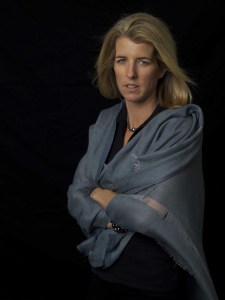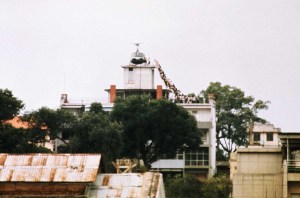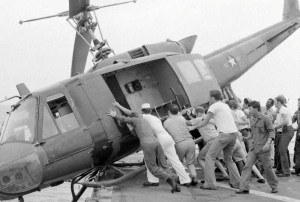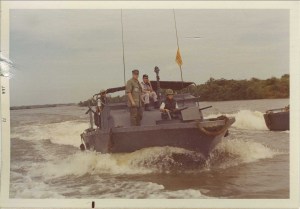
Rory Kennedy‘s Last Days in Vietnam follows the final weeks of the Vietnam War as the communist North Vietnamese Army closes in on Saigon. The alarmed South Vietnamese people, fearing imprisonment and potentially death, are eagerly trying to escape. But the U.S. Congress has pulled away their support and on the ground American soldiers and diplomats must make the difficult decision to risk treason and save the lives of as many South Vietnamese as possible in emergency and makeshift evacuations.
Kennedy is a producer and director, known for Ethel (2012) and Ghosts of Abu Ghraib (2007). Last Days in Vietnam is nominated for an Academy Award for best feature documentary. “We’re very thrilled,” said Kennedy. “It’s been a whirlwind. We’ve been able to do screenings in New York and L.A. and San Francisco which has been really great. It’s gotten a little burst of attention, which I always appreciate because it translates into more eyes on the film ultimately.”
Kennedy’s journey began when she was approached by American Experience/PBS Films to make a film about the final days of the war and she was immediately interested in the story. She had always been fascinated by the Vietnam War and felt it was a seminal moment in U.S. history. Then she began doing more research and realized what an extraordinary story the last days of the war was. It was one that she thought she knew but discovered there was so much more to it. “That’s been my experience with audiences as well, in terms of their response to the film. The dominant response has been a sense of already knowing the story but when we watch the film we are blown away by how much we don’t know and how important it is,” Kennedy noted.

Kennedy collaborated with writers Mark Bailey and Keven McAlester to write the story. “There are a lot of ways to approach the material and tell the story. I made the decision early on that I didn’t want to use a narrator. We had a goal of not using historians and people who didn’t have firsthand knowledge of what happened but we didn’t know if we could accomplish that feat,” Kennedy explained.
Faced with so many ways to look at the material, such as the politics of the war, how the U.S. entered the war, the history of the war, Kennedy decided to focus more on the personal story, which in this case was the human cost of war. “I was most excited about these stories of individuals and what happened to them, during that 24 hour period of time, during really the last day of the war. I wanted to get to that. That’s where I felt the drama was, that’s where the emotion was and that’s where the story was that I wanted to tell. We were all really on the same page about that,” she said.
 From there it was thousands of other decisions made to get to the final film. Collaboration was key to bringing this film together. “We have index cards on the wall about the events that happened and when, in what order that happened in and when you jump to Washington back to Saigon, when you go from the Embassy to the airport. How to unpack and give credence to this story about the Ambassador and understand his story,” Kennedy explained. All this involved working closely together to make the best choices for the film. “It was wonderful. I had a really great team…They played a really essential role and I had a fantastic editor, Don Kleszy, and we all worked very closely in the edit room together to bring the story to life,” Kennedy explained.
From there it was thousands of other decisions made to get to the final film. Collaboration was key to bringing this film together. “We have index cards on the wall about the events that happened and when, in what order that happened in and when you jump to Washington back to Saigon, when you go from the Embassy to the airport. How to unpack and give credence to this story about the Ambassador and understand his story,” Kennedy explained. All this involved working closely together to make the best choices for the film. “It was wonderful. I had a really great team…They played a really essential role and I had a fantastic editor, Don Kleszy, and we all worked very closely in the edit room together to bring the story to life,” Kennedy explained.
“[Kleszy] has a really strong sense of material and story. So he certainly played a significant role in the edit room,” Kennedy said. “He actually came on later on in the project. So we had already made some progress in the overall structure of the film, a very rough cut. He was able to come in with fresh eyes to that process which was helpful and again it was a constant collaboration. The writers and I and the editor were in that room everyday together.” Many times the team noted the sequence that they needed to build to help explain the story and they would look for the footage that would work. From there it was looking at the sequence with a critical eye to see if it really did work. The sequences built together with the appropriately placed transitions formed the larger story of the film. Figuring out if the information was clear wasn’t always easy.
 The biggest challenge though, laid in finding people to be interviewed. “For example, I really wanted to find one of the 420 people who were left behind at the embassy in the film and it was a struggle finding any of them. Ultimately we did and it was terrific. It plays an important role in the film,” Kennedy noted. Making these complex moments with a range of characters and a range of locations make sense without a narrator or any historians was also difficult. She made this choice to go without anything that wasn’t a firsthand account of someone who had actually experienced these last days because she wanted to have the audience come to their own conclusions without being told what to think. This choice also helps the audience experience the film in real time with the people who went through it.
The biggest challenge though, laid in finding people to be interviewed. “For example, I really wanted to find one of the 420 people who were left behind at the embassy in the film and it was a struggle finding any of them. Ultimately we did and it was terrific. It plays an important role in the film,” Kennedy noted. Making these complex moments with a range of characters and a range of locations make sense without a narrator or any historians was also difficult. She made this choice to go without anything that wasn’t a firsthand account of someone who had actually experienced these last days because she wanted to have the audience come to their own conclusions without being told what to think. This choice also helps the audience experience the film in real time with the people who went through it.
Sharing the film with audiences has been the most satisfying experience for Kennedy. One group especially stands out for her. Sharing the film with the Vietnamese community in the U.S. has been particularly meaningful. “I think for the vast majority of them it’s really the first time they’ve seen this entire story on film and many of them who live in this country were there during those final moments. Many of them got out during those times and had a harrowing experience and so the emotional response, the emails that I’ve gotten, the Q&As that have happened with that community has been really moving and touching,” Kennedy said.





